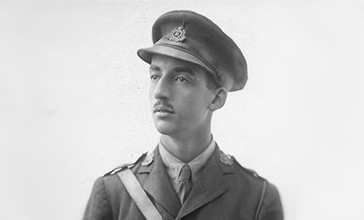23 August 2018
Worcester First World War hero remembered

To mark the end of the First World War Centenary, the Commonwealth War Graves Commission (CWGC) has launched its “Road to Peace” project. The project tells 120 personal stories of casualties who died during the final 100 days of the First World War, from 8 August to 11 November.
The stories have been compiled by the CWCG’s team of historians and includes the remarkable account of Lieutenant Peter Layard, a First World War hero from Malvern, Worcester who died on 23 August 1918 whilst trying to help a German soldier.
- The Commonwealth War Graves Commission is marking the end of the First World War Centenary with 120 personal stories of those who made the ultimate sacrifice in the last months of the war.
- The CWGC commemorates a staggering 120,000 men and women who died between 8 August and 11 November 1918.
- The stories have been compiled by the CWGC's team of historians and includes the remarkable account of Lieutenant Peter Layard, a First World War hero from Malvern, Worcester who died on 23 August 1918 whilst trying to help a German soldier.
Educated at Bedales School, an independent boarding school in Petersfield, Peter aged 18, applied for a Commission in the British Army, upon the outbreak of the First World War. After training, Peter was sent to France as a Second Lieutenant in the Suffolk Regiment. Peter arrived on the Western Front in January 1916, but was badly wounded while in command of a trench mortar. He returned to England to recover and spent two years in hospital.
The young Lieutenant arrived back at a turning point on the Western Front in June 1918 and soon took part in the Battle of Amiens in August, the first of many battles that would eventually lead to the Armistice. Peter then fought at Albert.
On the final day of fighting at Albert, Peter was in action near the French Village of Gommecourt. During the carnage, Peter bravely ran out to help a wounded German soldier. While binding the wounds of the soldier, Peter was shot and killed at 22 years old.
Stories like Lieutenant Peter Layard’s illustrate how empathy and understanding can survive even in the most terrible circumstances.
Peter was laid to rest in the CWGC Douchy-Les-Ayette British Cemetery. Upon his headstone are inscribed the words “Son of George Somes Layard, Enamored of Life, He went laughing, into the arms of death”. When the war ended, Peter’s sergeant wrote to Peter’s parents and said “No better soldier or gentleman ever wore the King’s Uniform”
From famous casualties like war poet Wilfred Owen, through to relatively unknown individuals; from those dying in battle to those who died of Spanish Flu; each story has been carefully chosen to shine a light on the human stories on the costly Road to Peace.
CWGC Historian, Max Dutton, explained: “Behind every one of our headstones or names a memorial to the missing, is a human story just waiting to be told. Our 100 days “Road to Peace” campaign will remind people of the human cost of the Great War, the sheer diversity of those who took part and the global nature of that sacrifice and remembrance today. We hope Peter’s story will inspire people to find out more about him and his comrades commemorated by the CWGC and visit their graves and memorials."
From 8 August – the 100th anniversary of the Allied victory at the Battle of Amiens – the “Road to Peace” campaign will conclude on 11 November with the stories of 11 people who died on the very last day of the First World War, even as the guns fell silent. The “100 Days” is a term applied to the final period of the First World War, during which the Allies launched a series of offensives on the Western Front that ultimately led to peace. Not actually 100 calendar days, the term is a reference to the final period of the Napoleonic Wars.
The Road to Peace stories will be shared across the CWGC’s digital channels on Facebook, Twitter and Instagram. A story will appear every day – with a more in-depth feature appearing weekly.

